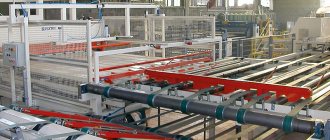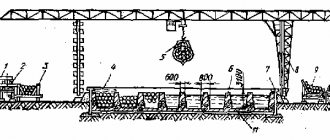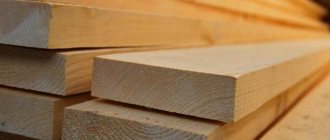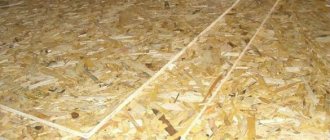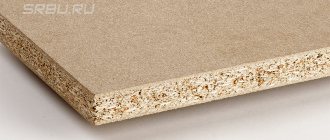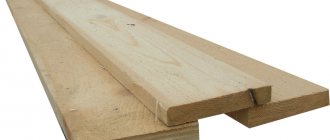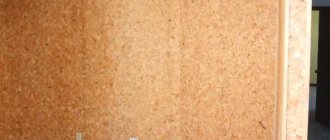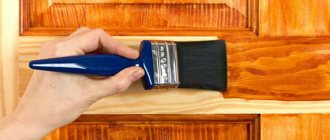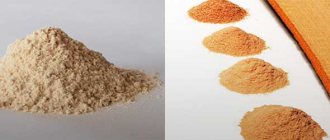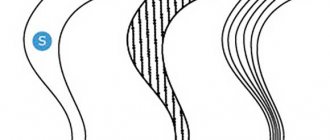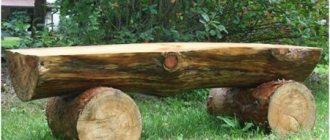All about veneer and MDF -> How to make veneer at home
Veneer is a very thin sheet of wood, the thickness of which can vary from 0.1 to 12 mm.
For industrial purposes, veneer is often made from valuable wood species such as oak, ash, beech, walnut, mahogany and others. But if you need veneer for personal purposes in small quantities, for example, for aircraft modeling, then you can read how veneer is made at home and, if you have the tools, do it yourself. In this article we want to talk about how to make veneer with your own hands.
How to make veneer at home
The easiest way to get yourself a few pieces of veneer is to “disassemble” a sheet of plywood. Place the plywood sheet in a container with hot water for 2-3 hours, maintaining a high temperature throughout the soaking period, and then cut the plywood into layers with a well-sharpened knife. Immediately after this, you need to put the resulting veneer slabs under a press to maintain a flat surface.
You can even make sawn veneer at home, but be prepared that this work will take a lot of effort and time.
All you need is a prepared timber (not necessarily elite wood, ordinary maple or birch will do), a pencil, a ruler, a workbench and a good jigsaw, preferably with a set of replacement blades in reserve. Fix the workpiece in the workbench and mark it vertically in increments of 10-12 mm (thicker is not practical, and if thinner, it will be very difficult to saw). Take a jigsaw in your hands and cut the veneer along the lines layer by layer.
How to make veneer if you have a plane at home. Sliced veneer is made from the same timber as sawn timber, with the only difference being that thinner plates can be made.
But there is also a downside to the coin - it is difficult to make plates of the same thickness with a mechanical plane. Well, if you have an electric plane with an adjustable layer thickness control, then the task is much easier. Firmly secure the timber in the workbench and remove the veneer, remembering to use a clamping ruler or beam.
If you have access to a peeler or other woodworking machines, then the process of obtaining veneer is no different from the industrial one. How to make veneer suitable for further use? It must be sanded, coated with waterproof solutions or varnished, depending on the purpose of production.
Alas, the foreigners are right: we use whole trees for firewood, but we have learned to make furniture from sawdust. It’s good that many enterprises have switched to finishing these products using veneer.
The products began to look richer. Veneer has always been a decoration for wooden products. The finishing looks especially beautiful using combinations of veneers from various types of wood.
Veneer peeling scheme.
So, let's look at how veneer is produced.
Veneer is usually called a thin piece of wood. They are made in various ways, let's consider three main ones: sawing, planing and peeling.
In any case, to produce veneer you will need:
- drying chamber; equipment for determining wood moisture content; equipment for direct production of veneer (depending on the method of production of the material).
So, you have to initially soak the wood for some time in water (the time depends on the density of the wood and its initial condition) and steam it.
Soaking and steaming are necessary to give the wood the same physical properties throughout its entire volume.
Open the veneer.
Otherwise, you risk damaging the interior of the wood or even rendering the equipment unusable.
Next comes the drying process in a drying chamber. Natural drying of the wood will not give the uniformity you were striving for. Insufficiently dry wood is not used in the production of veneer, since in this case the percentage of defects is very high.
The moisture content of wood can also be checked in a homemade way using a laboratory hygrometer. To do this, cut a small section of wood and place a thermometer in the sawdust.
The second thermometer remains open. Humidity is determined by the difference in thermometer readings and using a table. This method is not entirely reliable, because it gives very noticeable deviations from real results.
Return to contents
Plywood manufacturing technology.
Sawing veneer is similar to sawing an ordinary board. But the requirements for the sawmill are much stricter: very precise adjustment of the cutting planes is required, and the wood feeding speed is much lower than usual. The veneer turns out even, smooth, requiring virtually no modification.
Band sawmills are quite suitable for this method of veneer production. There is only one thing to consider: about 60% of wood inevitably turns into sawdust. Let's call this a payment for the quality of veneer, but when using valuable types of wood, this production method is not used.
High-quality material obtained by sawing is always used to produce expensive goods. They decorate furniture with it. The soundboards of musical instruments are made from the same veneer.
Veneer obtained by sawing must still “ripen” for a certain time in a darkened room where a certain humidity is maintained. In mass production, the resulting veneer is kept under pressure for a short time.
This is a completely unnecessary procedure, since after sawing the wood can be heated, and the process of moisture evaporation will accelerate. This can cause various distortions and bends. It is better to play it safe and avoid damage to the material by placing it under a press.
It is much easier to obtain veneer by planing. Don’t be alarmed: it was only in the Middle Ages that veneer was planed from an ordinary board using a plane. Nowadays, everything is much more technologically advanced: a block of wood (namely a block!) is fixedly fixed on a workbench, and a wide, sharp knife removes a layer of a given thickness.
Here's the veneer for you. The equipment requirements are the same: very precise settings, low feed speed.
The knife must have a certain sharpening angle, which is selected depending on the thickness of the required veneer and the density of the wood. This veneer is very often used for the production of plywood. For plywood to be of high quality, the veneer must be of the same quality.
True, this rule is often abandoned in production in favor of the quantity of goods produced. At the same time, it is completely forgotten that at the final stage the plywood is pressed, which means the veneer is subjected to a rather impressive load. When its quality is low, normal cracking occurs.
Return to contents
Veneer obtained by peeling is the lowest cost. Veneer is made in this way very simply: a wooden blank is placed on a lathe, and its rough and primary processing is carried out.
The workpiece becomes even and smooth. And then, simultaneously along the entire length, a certain, predetermined layer is removed. Wood for such production does not have to be dry.
Rather, on the contrary: damp wood will be easier to peel. But the feed of the cutting element must be carefully adjusted.
This method of veneer production is used to make ordinary matches. Don’t be surprised: later the aspen veneer is crushed into thin strips and cut into small pieces. And then you can guess for yourself.
Veneer refers to wood materials that have the form of thin sheets of wood, the thickness of which ranges from 0.5-3.0 mm. Veneer is usually glued to wood panels or fiberboard, thus giving the material a more aesthetic and attractive appearance.
Scheme for laying and marking veneer.
Production by peeling method
Veneer obtained by peeling is the lowest cost. Veneer is made in this way very simply: a wooden blank is placed on a lathe, and its rough and primary processing is carried out. The workpiece becomes even and smooth. And then, simultaneously along the entire length, a certain, predetermined layer is removed. Wood for such production does not have to be dry.
Rather, on the contrary: damp wood will be easier to peel. But the feed of the cutting element must be carefully adjusted. This method of veneer production is used to make ordinary matches. Don’t be surprised: later the aspen veneer is crushed into thin strips and cut into small pieces. And then you can guess for yourself.
Varieties of veneer
Veneer is divided into various types. Depending on the production method, the material is divided into:
- peeled; sawn; planed.
Types of veneer.
Depending on the appearance, veneer is divided into the following types:
Natural. This material takes the form of thin sheets of natural color and structure.
The main task in the production of such material is to preserve the naturalness of the wood. The advantages of natural veneer are its environmental friendliness, preservation of the unique structure of wood, and attractive appearance. Products finished with the material are similar to products made from solid wood, but cost an order of magnitude lower, and the weight of the structure is less. Colored.
When producing colored veneer, its surface is painted and treated with stain. As a result, the material comes in a wide range of colors. Fine-line. This type of material is obtained as a result of the reconstruction of peeled veneer obtained from softwood.
Initially, blocks are formed, from which veneers of various structures, patterns and colors of natural wood are subsequently produced. This method allows you to imitate valuable wood species when making material from cheaper wood. As a result, veneer has a more aesthetic appearance and costs less.
Veneer has found application in the manufacture of various structures and products.
The most popular material is for finishing doors, furniture, and for making plywood. It is also quite often used in the production of guitar bodies and for decorative work. In addition, veneer is widely used in car tuning and interior trim.
It is worth noting that some manufacturers save on high-quality glue and varnish by using low-quality compounds. All this significantly affects the environmental friendliness of the product.
Equipment
Regardless of the method of manufacturing veneer (sawing, peeling, planing), to organize production for its production you will need:
- wood drying chamber;
- apparatus that determines wood moisture content;
- production equipment.
Drying chambers for material are expensive. The cost starts from 2.5 million rubles. Without sufficient funds to start a business, you can order a wood drying service. The cost for 1 cubic meter starts from 900 rubles.
Devices for measuring wood moisture differ in performance and functionality. The lowest cost of the device is around 900 rubles. The cost limit for a moisture meter is within 50,000 rubles.
The cost of equipment for producing veneer starts from 500,000 rubles. For example, a digitally controlled peeling machine from Chinese manufacturers will cost 495,000 rubles.
A guillotine is needed for finishing trimming of veneer. With its help, veneer is cut to specified sizes, and defective areas are cut out. The veneer is cut straight and parallel. For a guillotine from a Chinese manufacturer you will need to pay 1,300,000 rubles.
Veneer manufacturing methods
Veneer manufacturing scheme.
As mentioned above, veneer is divided into three types according to the manufacturing method. Let's take a closer look at these methods of producing material.
Peeling method. In this case, specially prepared wood is used, and when rotated, the top layer is removed using a special machine. In the production of veneer using the peeling method, soft and hard woods are used.
With this treatment, the top layer is cut off spirally. The result is large sheets of veneer, but their pattern is not very clear and bright. Therefore, peeled veneer is most often glued to plywood. Planing method.
With this method, the top layer of wood is cut in the transverse or longitudinal direction. This type of veneer is made only from hardwood. The result is a sheet of material of fairly high density with a bright and beautiful pattern.
Therefore, sliced veneer is used in the production of furniture and doors. Sawing method. In this case, veneer is obtained by sawing sheets with a minimum thickness from a prepared log. The material obtained by this method is the most expensive, since a large amount of waste is generated during production.
When producing veneer, it is important to pay attention to the quality of the wood itself. The tree must have a straight trunk with a minimum number of twigs and branches. The prepared log is inspected by a specialist and determined by him for one or another processing method.
Materials
Sliced veneer is made from a wide variety of materials. These are the most common conifers in Russia, aspen and birch. However, they are not valued very highly - external simplicity affects them.
Valuable wood is used much more actively for finishing - it is rare and beautiful. For example:
- oak,
- ash,
- hornbeam,
- beech,
- cherry,
- pear,
- maple,
- nut and others.
And, of course, exotic materials look more beautiful than others:
- tiger tree,
- teak,
- zebrano,
- patchouli,
- mahogany,
- paduk,
- leyswood,
- sukupira,
- sapele and so on.
Making veneer yourself
You can make veneer with your own hands at home.
Production of sliced veneer.
Of course, for this you need to have a special tool and have at least some skill in working with wood.
To make sawn veneer you will need a blank in the form of a beam. The surface of the workpiece is lined with vertical stripes with a pitch of no more than 12 mm. After this, the timber is secured in the workbench and cut along the marks using a jigsaw.
Sliced veneer is initially made in a similar way to sawn veneer, but then the surface is processed with a mechanical or electric planer. It is better, of course, to choose an electric planer, as it provides better processing quality. In this case, you need to work extremely carefully so that the thickness of all veneer sheets is the same.
To produce peeled veneer, you will need a blank with a round cross-section.
Therefore, you will need a sharpening machine to obtain a cylindrical workpiece or a finished log. Further veneer manufacturing technology is similar to the processes described above. The only difference is that it turns out to be a large sheet of material.
Further processing of the resulting veneer depends on the personal preferences of the owner. To obtain the desired effect, grinding and treatment with paints and protective compounds are carried out.
Veneer refers to wood materials that have the form of thin sheets of wood, the thickness of which ranges from 0.5-3.0 mm. Veneer is usually glued to wood panels or fiberboard, thus giving the material a more aesthetic and attractive appearance.
Scheme for laying and marking veneer.
Varieties of veneer
Veneer is divided into various types. Depending on the production method, the material is divided into:
- peeled; sawn; planed.
Types of veneer.
Depending on the appearance, veneer is divided into the following types:
Natural. This material takes the form of thin sheets of natural color and structure.
The main task in the production of such material is to preserve the naturalness of the wood. The advantages of natural veneer are its environmental friendliness, preservation of the unique structure of wood, and attractive appearance. Products finished with the material are similar to products made from solid wood, but cost an order of magnitude lower, and the weight of the structure is less. Colored.
When producing colored veneer, its surface is painted and treated with stain. As a result, the material comes in a wide range of colors. Fine-line. This type of material is obtained as a result of the reconstruction of peeled veneer obtained from softwood.
Initially, blocks are formed, from which veneers of various structures, patterns and colors of natural wood are subsequently produced. This method allows you to imitate valuable wood species when making material from cheaper wood. As a result, veneer has a more aesthetic appearance and costs less.
Veneer has found application in the manufacture of various structures and products.
The most popular material is for finishing doors, furniture, and for making plywood. It is also quite often used in the production of guitar bodies and for decorative work. In addition, veneer is widely used in car tuning and interior trim.
It is worth noting that some manufacturers save on high-quality glue and varnish by using low-quality compounds. All this significantly affects the environmental friendliness of the product.
Veneer manufacturing methods
Veneer manufacturing scheme.
As mentioned above, veneer is divided into three types according to the manufacturing method. Let's take a closer look at these methods of producing material.
Peeling method. In this case, specially prepared wood is used, and when rotated, the top layer is removed using a special machine. In the production of veneer using the peeling method, soft and hard woods are used.
With this treatment, the top layer is cut off spirally. The result is large sheets of veneer, but their pattern is not very clear and bright. Therefore, peeled veneer is most often glued to plywood. Planing method.
With this method, the top layer of wood is cut in the transverse or longitudinal direction. This type of veneer is made only from hardwood. The result is a sheet of material of fairly high density with a bright and beautiful pattern.
Therefore, sliced veneer is used in the production of furniture and doors. Sawing method. In this case, veneer is obtained by sawing sheets with a minimum thickness from a prepared log. The material obtained by this method is the most expensive, since a large amount of waste is generated during production.
When producing veneer, it is important to pay attention to the quality of the wood itself. The tree must have a straight trunk with a minimum number of twigs and branches. The prepared log is inspected by a specialist and determined by him for one or another processing method.
